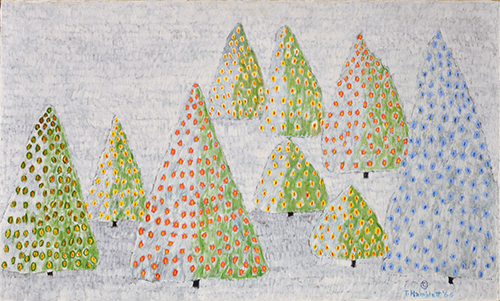By: Tom Freeland, HottyToddy.com, Blogger
My last post referred to Theora Hamblett, a great artist from Oxford. Miss Hamblett had taught in a one-room schools in the county before 1930, and then moved to town where she ran a boarding house and did work as a seamstress. In 1950, she took some art classes at Ole Miss (one of her classes was also historically important as the first integrated class at the school– a black artist had showed potential to the art professor, who arranged to have him hired as a janitor in the art building, and then allowed him to participate in the class from a closet in the back of the classroom. He became an artist in his own right, and one of his paintings depicts that classroom).
Miss Hamblett painted a number of series of paintings, the most prominent what are called children’s games and dreams and visions. She sold the games paintings (and related paintings of farm and rural activity) but kept the dreams and visions for herself. If you visited her in her home, the house was full of the dreams and visions paintings, and she would tour trusted guests through those. She only let a few go during her lifetime– the exploding butterfly above is one. When she died, the University Museum got the rest, such as the golden curtain, below (a part of a series of paintings of a dream in which she saw her departed relatives, and then a golden curtain descended, a story she told me while standing in front of these pictures, visiting her in her home.
 By the end of the sixties, Miss Hamblett’s pictures were in major collections– the Metropolitan Museum of Art, the Rockefeller’s art collection, etc. I have always been convinced that she would have been even more recognized if the dreams and visions paintings were more visible in the outside world. In any event, it is clear that she is one of the major visual artists Mississippi produced in her era, standing with Walter Anderson and Eudora Welty’s photographs.
By the end of the sixties, Miss Hamblett’s pictures were in major collections– the Metropolitan Museum of Art, the Rockefeller’s art collection, etc. I have always been convinced that she would have been even more recognized if the dreams and visions paintings were more visible in the outside world. In any event, it is clear that she is one of the major visual artists Mississippi produced in her era, standing with Walter Anderson and Eudora Welty’s photographs.
Ignatius asked about how she viewed the business part of being an artist, and I said I had a couple of stories about that and would post them.
 My father told me both of these stories. The second he had essentially first hand, and the first, I think, he heard from Miss Hamblett. She was a cousin of my grandmother’s, not close but close enough to be acknowledged (which was part of my entry to going and visiting her in high school and college).
My father told me both of these stories. The second he had essentially first hand, and the first, I think, he heard from Miss Hamblett. She was a cousin of my grandmother’s, not close but close enough to be acknowledged (which was part of my entry to going and visiting her in high school and college).
First, about the painting the Metropolitan Museum of Art bought from Miss Hamblett. I think this story is from the early-to-middle sixties. Her name was becoming noted, and someone from the Met turned up to buy a painting. Miss Hamblett showed them what was available, and the buyer looked it over, selected a painting, and began haggling about the price.
The price was arrived at, and the buyer was ready to make the purchase. Miss Hamblett said that she would send the painting up at a later date, and said how long that would be.
The buyer said, why can’t I take it now?
Miss Hamblett said, “At that price, I’m going to make you a copy.”
The buyer paid the original price.
 Second involves the © symbol in her pictures. In the 1960s, UNICEF used Miss Hamblett’s paintings for Christmas cards. Sometime thereafter, she got word that someone out there was thinking about publishing a children’s book using her children’s games pictures. She came to my father with her problem: How could she keep people from stealing her pictures?
Second involves the © symbol in her pictures. In the 1960s, UNICEF used Miss Hamblett’s paintings for Christmas cards. Sometime thereafter, she got word that someone out there was thinking about publishing a children’s book using her children’s games pictures. She came to my father with her problem: How could she keep people from stealing her pictures?
He explained to her the then-state of copyright law: That to be sure of her protection, she should put the copyright symbol on her pictures, and date, and then explained to her the process (and fee) for registering her copyright.
She balked at the fee, and said, “but if I don’t register, who would ever know?” And so she carefully put a © on each painting (and I’d bet there’s not one instance of registration) thereafter.
Read more blog posts by Tom Freeland at his NMissCommentor blog page.


